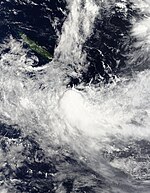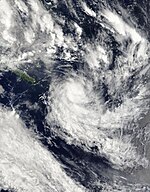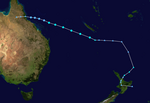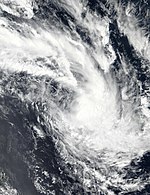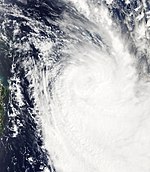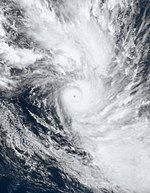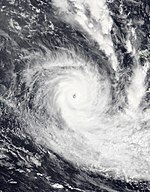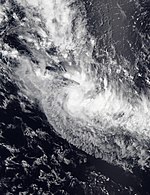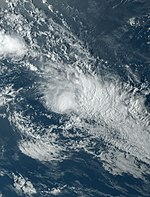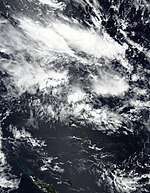2022–23 South Pacific cyclone season: Difference between revisions
Nino Marakot (talk | contribs) Tags: Mobile edit Mobile web edit Advanced mobile edit |
→Systems: Update. The JTWC canceled the TCFA. Tags: Mobile edit Mobile app edit Android app edit |
||
| Line 301: | Line 301: | ||
| Pressure=1006 |
| Pressure=1006 |
||
}} |
}} |
||
On March 11, the FMS reported that Tropical Disturbance 11F had developed, within an environment of warm sea surface temperatures, low wind shear and moderate upper divergence, to the west of [[Tonga]].<ref>{{cite report|title=Tropical Disturbance Summary for area Equator to 25S, 160E to 120W issued at Mar 110810 UTC|url=https://tgftp.nws.noaa.gov/data/raw/ww/wwps21.nffn..txt|date=March 11, 2023|accessdate=March 12, 2023|publisher=[[Fiji Meteorological Service]]|archive-date=March 12, 2023|archive-url=http://archive.today/2023.03.12-041501/https://www.wis-jma.go.jp/d/o/NFFN/Alphanumeric/Warning/Warnings_and_weather_summary/20230311/060000/A_WWPS21NFFN110600_C_RJTD_20230311081117_44.txt}}</ref> The agency gave the system a moderate chance to develop further.<ref>https://www.met.gov.fj/aifs_prods/20036.txt</ref> The JTWC, meanwhile, had issued a TCFA on March 13.<ref>{{cite JTWC|date=13 March 2023|type=tcfa|designation=91P|url=https://www.metoc.navy.mil/jtwc/products/sh9123web.txt|archive-url=https://wiki.chlod.net/jtwc/text/2023-03-13-0130-sh9123web.txt}}</ref> |
On March 11, the FMS reported that Tropical Disturbance 11F had developed, within an environment of warm sea surface temperatures, low wind shear and moderate upper divergence, to the west of [[Tonga]].<ref>{{cite report|title=Tropical Disturbance Summary for area Equator to 25S, 160E to 120W issued at Mar 110810 UTC|url=https://tgftp.nws.noaa.gov/data/raw/ww/wwps21.nffn..txt|date=March 11, 2023|accessdate=March 12, 2023|publisher=[[Fiji Meteorological Service]]|archive-date=March 12, 2023|archive-url=http://archive.today/2023.03.12-041501/https://www.wis-jma.go.jp/d/o/NFFN/Alphanumeric/Warning/Warnings_and_weather_summary/20230311/060000/A_WWPS21NFFN110600_C_RJTD_20230311081117_44.txt}}</ref> The agency gave the system a moderate chance to develop further.<ref>https://www.met.gov.fj/aifs_prods/20036.txt</ref> The JTWC, meanwhile, had issued a TCFA on March 13.<ref>{{cite JTWC|date=13 March 2023|type=tcfa|designation=91P|url=https://www.metoc.navy.mil/jtwc/products/sh9123web.txt|archive-url=https://wiki.chlod.net/jtwc/text/2023-03-13-0130-sh9123web.txt}}</ref> However, a day later the same agency canceled the TCFA. <ref>{{cite web|url=https://www.metoc.navy.mil/jtwc/products/sh9123web.txt|archive-url=https://ghostarchive.org/archive/uiFvA|date=14 March 2023|access-date=14 March 2023|archive-date=14 March 2023|title=Current Southern Hemisphere Tropical Systems Tropical Cyclone Formation Alert WTPS21 Cancelled Issued at 14/0130Z (Invest 91P)|website=JTWC|language=en}}</ref> |
||
{{clear}} |
{{clear}} |
||
Revision as of 16:57, 14 March 2023
This article needs to be updated. (February 2023) |
| 2022–23 South Pacific cyclone season | |
|---|---|
 Season summary map | |
| Seasonal boundaries | |
| First system formed | December 10, 2022 |
| Last system dissipated | Season ongoing |
| Strongest storm | |
| Name | Kevin |
| • Maximum winds | 215 km/h (130 mph) (10-minute sustained) |
| • Lowest pressure | 925 hPa (mbar) |
| Seasonal statistics | |
| Total disturbances | 12 |
| Total depressions | 7 |
| Tropical cyclones | 5 |
| Severe tropical cyclones | 3 |
| Total fatalities | 16 |
| Total damage | $8.12 billion (2022 USD) (Costliest South Pacific cyclone season recorded) |
| Related articles | |
The 2022–23 South Pacific cyclone season is the period of the year when most tropical cyclones form within the South Pacific Ocean to the east of 160°E. The season officially started on November 1, 2022, and will end on April 30, 2023, however a tropical cyclone could form at any time between July 1, 2022, and June 30, 2023, and would count towards the season total. During the season, tropical cyclones will be officially monitored by the Fiji Meteorological Service, Australian Bureau of Meteorology and New Zealand's MetService. The United States Armed Forces through the Joint Typhoon Warning Center (JTWC) will also monitor the basin and issue unofficial warnings for American interests. The FMS attaches a number and an F suffix to tropical disturbances that form in or move into the basin while the JTWC designates significant tropical cyclones with a number and a P suffix. The BoM, FMS and MetService all use the Australian Tropical Cyclone Intensity Scale and estimate windspeeds with a period of approximately ten minutes, while the JTWC estimates sustained winds over a 1-minute period, which are subsequently compared to the Saffir–Simpson hurricane wind scale (SSHWS).
Seasonal forecasts
| Source/Record | Tropical Cyclone |
Severe Tropical Cyclone |
Ref |
|---|---|---|---|
| Records | |||
| Average (1969-70 - 2021–22): | 7 | 3 | [1] |
| Record high: | 1997–98: 16 | 1982–83: 10 | [2] |
| Record low: | 1990–91: 2 | 2008–09: 0 | [2] |
| Predictions | |||
| CWCL July | 6–9 | — | [3] |
| CWCL August | 6–9 | — | [4] |
| CWCL October | 6–10 | — | [5] |
| NIWA October | 6–10 | 3–4 | [6] |
| Fiji Meteorological Service | 5–7 | 1–4 | [1] |
During July 2022, the Centre for Water, Climate and Land (CWCL) at Australia's Newcastle University, issued its first long-range tropical cyclone outlook for the 2022–23 season.[3] Within the outlook, the CWCL took into account the persistent La Niña like conditions across the Tropical Pacific Ocean, that were expected to continue and the modelled sea surface temperatures over the Indian Ocean, which pointed towards a negative Indian Ocean Dipole event occurring.[3] As a result, they predicted that the South Pacific region between 135°E and 120°W, would see a near-normal tropical cyclone season, with between six and nine tropical cyclones occurring during the season.[3]
They also predicted that French Polynesia, Niue, Northern New Zealand, Papua New Guinea, Tokelau, Tonga, Tuvalu, Wallis & Futuna, the Cook, Samoan and Pitcairn Islands, had a below normal of being impacted by a tropical cyclone.[3] Fiji, New Caledonia and the Solomon Islands were thought to have a near-normal chance of being impacted by one or more tropical cyclones, while Vanuatu was expected to face an above-normal chance of being impacted by one or more tropical cyclones.[3] The CWCL subsequently updated its forecast during August and predicted that the Solomon Islands and Vanuatu, would face a below-normal risk of being impacted by one or more tropical cyclones.[4] They also predicted that Papua New Guinea now faced an above-average chance of being impacted by one or more tropical cyclones.[4] During October, the CWCL issued their final outlook before the cyclone season started and noted that the Solomon Islands, Northern New Zealand and Vanuatu, now faced a near-normal risk of being impacted by one or more tropical cyclones.[5]
New Zealand's National Institute of Water and Atmospheric Research (NIWA) subsequently published the Southwest Pacific Tropical Cyclone Outlook, which took into account CWCL's tropical cyclone outlooks, as well as the El Niño-Southern Oscillation conditions that were present over the basin and forecast to occur during the season.[6] The outlook called for a near-average number of tropical cyclones for the 2022–23 season, with six to ten named tropical cyclones, predicted to occur between 135°E and 120°W, compared to an average of just under 9.[6] Three or four of the tropical cyclones were expected to intensify further and become severe tropical cyclones, while it was noted that a Category 5 severe tropical cyclone could occur during the season.[6]
The BoM issued two seasonal forecasts for the Southern Pacific Ocean, for their self-defined eastern and western regions of the South Pacific Ocean. They predicted that the Western region between 142.5°E and 165°E, had a 65% chance of seeing more than 4 tropical cyclones, while the Eastern Region between 165°E and 120°W, had a 43% chance of seeing more than 6 tropical cyclones.[7]
Seasonal summary

Systems
Tropical Depression 01F
| Tropical depression (Australian scale) | |
| Duration | December 10 – December 12 |
|---|---|
| Peak intensity | Winds not specified; 1005 hPa (mbar) |
On December 10, the FMS reported that Tropical Disturbance 01F had developed, within an area of low vertical windshear near Fiji's southern Lau Islands.[8] Moving southward under a moderate sheared environment with warm sea surface temperatures,[9][10] 01F intensified into a tropical depression late on December 11, before being steered into a highly sheared environment due to an upper ridge to its north and an approaching upper trough from its west.[11] It later moved into TCWC Wellington's area of responsibility, where it was reclassified as a deepening non-tropical low.[12] It was last noted on December 13, near New Zealand.[13]
Tropical Disturbance 02F
| Tropical disturbance (Australian scale) | |
| Duration | December 29 – December 31 |
|---|---|
| Peak intensity | Winds not specified; 999 hPa (mbar) |
Late on December 29, the FMS reported that Tropical Disturbance 02F had developed to the south of Vanuatu.[14][15] The JTWC gave it a low chance for development due to the system having a fully obscured LLC and in a favorable environment of low wind shear, good poleward outflow and warm sea surface temperatures.[16] At 3:00 UTC on December 30, the JTWC announced that the system had transitioned into a subtropical cyclone, however the agency gave the system a low chance to develop into tropical cyclone due to persistent unfavorable environment.[17] The system then moved into TCWC Wellington's area of responsibility on the next day,[18] where it was reclassified as a non-tropical low.[19]
Tropical Disturbance 03F
| Tropical disturbance (Australian scale) | |
| Duration | January 5 – January 7 |
|---|---|
| Peak intensity | Winds not specified; 1000 hPa (mbar) |
Late on January 5, the FMS reported that Tropical Disturbance 03F had formed near New Caledonia.[20] The system generally moved southeast before the FMS ceased advisories on the system, on January 7.[21] However, on January 8, the JTWC gave the system's chance for development, although in favorable environment, as low since it was in close proximity with Hale.[22] But upon reanalysis, convection re-fired, and an eye feature was visible,[23] although the JTWC later reported that the system had dissipated the following day.[24]
Tropical Cyclone Hale
| Category 1 tropical cyclone (Australian scale) | |
| Tropical storm (SSHWS) | |
| Duration | January 7 (Entered basin) – January 8 |
|---|---|
| Peak intensity | 75 km/h (45 mph) (10-min); 994 hPa (mbar) |
On January 7, Tropical Low 07U moved into the basin from the Australian region, when it was immediately reclassified as Tropical Depression 04F by the FMS.[25] Late on the same day, it intensified into a Category 1 tropical cyclone, with the FMS naming it as Hale.[26] At that time, the storm was feeling the effects of moderate wind shear, with its convective structure splitting into two different regions,[27] before it started to weaken as shear increased and its low-level center became elongated.[28] The FMS issued their last advisory on Hale by the next day as it moved east-southeast towards the TCWC Wellington's area of responsibility,[29] where they reclassified it as an extratropical low six hours later.[30] The JTWC subsequently discontinued warnings on the system three hours later.[31]
In preparation for Hale, MetService issued heavy rain and wind warnings for many parts of New Zealand.[32] A state of emergency was later declared in the northeastern part of New Zealand as it approached the country.[33] Hale caused widespread flooding and slips in northern and eastern parts of the country on January 10 and 11, particularly in the Coromandel and Gisborne areas.[34] Washed away forestry slash clogged many rivers in the Gisborne region, exacerbating the flooding and accumulating around bridges downstream.[35] Several metres of foreshore was eroded away by the storm surge in Whitianga, threatening waterfront buildings such as the Mercury Bay Boating Club.[36] A child was killed on Waikanae Beach on January 25, two weeks after Hale impacted the country, after falling while playing on forestry slash debris left behind by the cyclone.[37]
Tropical Cyclone Irene
| Category 2 tropical cyclone (Australian scale) | |
| Tropical storm (SSHWS) | |
| Duration | January 14 – January 19 (Out of basin on 16–17 January) |
|---|---|
| Peak intensity | 100 km/h (65 mph) (10-min); 985 hPa (mbar) |
By early January 13, the FMS noted that a low pressure system was expected to develop to the west of Vanuatu in the next 5 days, and gave it a moderate chance of development.[38] However, the low formed in the Australian region late on the same day,[39] and by January 14, it organized into a tropical disturbance, with the FMS designating it as 05F.[40] 05F briefly entered the basin by the next day,[41] before subsequently moving back to the Australian region late by the same day.[42]
By January 17, 05F moved back into the South Pacific basin, where it was upgraded to a tropical depression by the FMS.[43] At 03:00 UTC on January 18, the JTWC's began issuing warnings on the system, classifying it as Tropical Cyclone 09P.[44] The FMS subsequently followed suit, upgrading the system into a Category 1 tropical cyclone on the Australian scale and naming it Irene.[45] At that time, satellite imagery showed Irene was quickly developing a central dense overcast (CDO).[46] Under a favorable environment of warm sea surface temperatures, low wind shear and strong poleward outflow,[47] Irene intensified into a Category 2 tropical cyclone late on the same day.[48] However, as it moved over Tanna Island in Vanuatu, its weakly-defined and elongated low-level circulation center quickly became exposed due to the wind shear,[49] prompting the JTWC to issue its final warning on Irene and reclassify the system as a subtropical cyclone by January 19.[50] The FMS subsequently downgraded Irene into a Category 1 tropical cyclone,[51] and continued to issue warnings as it weakened while moving east-southeast, before declaring the system an extratropical cyclone late on the same day.[52] Irene was last noted the next day.[53]
A heavy rain alert was issued for some parts of Fiji and the public was advised to be on high alert.[54] Similar warnings were also issued to Vanuatu. On January 19, Irene caused flooding and power cuts in Port Villa.[55]
Tropical Depression 06F
| Tropical depression (Australian scale) | |
| Tropical storm (SSHWS) | |
| Duration | January 20 (Entered basin) – January 22 |
|---|---|
| Peak intensity | 55 km/h (35 mph) (10-min); 996 hPa (mbar) |
On January 20, a tropical low entered the basin from the Australian region, where the FMS immediately designated the system as Tropical Depression 06F.[56] Later on the same day, the JTWC upgraded the system into a tropical storm, and designating it as Tropical Cyclone 10P, although the system was becoming exposed due to a dry air infiltration.[57] With the system becoming fully exposed due to increasing wind shear and large amounts of dry air, the JTWC issued their final advisory on 06F the next day.[58] The FMS continued to issue advisories on 06F as it continued east-southeast,[59] before turning south-southwest and weakening into a low pressure area by January 22.[60] The remnants of the system impacted New Zealand on January 27, causing severe flooding and killing 4 people.[61]
Severe Tropical Cyclone Gabrielle
| Category 3 severe tropical cyclone (Australian scale) | |
| Category 2 tropical cyclone (SSHWS) | |
| Duration | February 10 (Entered basin) – February 11 |
|---|---|
| Peak intensity | 150 km/h (90 mph) (10-min); 958 hPa (mbar) |
On February 10, Severe Tropical Cyclone Gabrielle moved into the basin from the Australian region, as a Category 3 severe tropical cyclone on the Australian scale.[62][63] Gabrielle began to experience an increase in northwesterly vertical wind shear, the JTWC downgraded it to a Category 1-equivalent cyclone.[64] Later that day, Gabrielle moved into MetService's area of responsibility.[65] By 21:00 UTC, the low-level circulation became fully exposed on the central convection, the JTWC discontinued warnings on the system.[66] Later the next day, Gabrielle was downgraded to a Category 2 tropical cyclone by the MetService.[67] Gabrielle subsequently passed directly over Norfolk Island.[68][69] The BoM and MetService reported that Gabrielle had transitoned into a deep subtropical low later that day.[70] The JTWC classified it as a subtropical storm.[71]
Weather warnings were issued across Norfolk Island and New Zealand,[72] with multiple states of emergency being declared in New Zealand as the cyclone impacted the country.[73] Heavy rain and strong winds led to widespread power outages and flooding across the upper North Island, with a national state of emergency being declared on February 14.[74] Two people were killed in Muriwai, while eight others were killed in Hawke's Bay, and one person killed in Gisborne.[75] New Zealand declared a national state of emergency for the third time in its history on February 14 as Cyclone Gabrielle caused widespread flooding, landslides and huge ocean swells.[76]
Severe Tropical Cyclone Judy
| Category 4 severe tropical cyclone (Australian scale) | |
| Category 3 tropical cyclone (SSHWS) | |
| Duration | February 23 – March 4 |
|---|---|
| Peak intensity | 175 km/h (110 mph) (10-min); 945 hPa (mbar) |
On February 22, the FMS reported that a low-pressure system was located just south of Samoa, and gave it a low chance of formation into a tropical cyclone in the next 5 days.[77] Under a moderate sheared environment and warm sea surface temperatures, the system organized into a tropical disturbance late on the next day, with the FMS designating it as 08F.[78] The disturbance steered southwest from a subtropical ridge on February 26 after upgrading to a tropical depression.[79] During February 26, the JTWC issued a Tropical Cyclone Formation Alert (TCFA) on the system.[80] The system was upgraded to a Category 1 tropical cyclone and attained the name Judy from the FMS after improved organization the same day.[81] The JTWC also upgraded the system to Tropical Cyclone on February 27, initiating advisories on it as Tropical Cyclone 15P.[82] Judy further developed due to high sea surface temperatures of 30 °C (86 °F), leading to the FSM to upgrade its status to Category 2 tropical cyclone the same day,[83] before upgrading further to a Category 3 severe tropical cyclone on February 28.[84] Judy eventually became a Category 4 on the Australian scale and Category 3 on the SSHWS. The system began to weaken as it headed southeastward. The JTWC issued their last warning on the system on March 3 as it became extratropical. By this time, the FMS had downgraded the system to Category 2 tropical cyclone status.
Severe Tropical Cyclone Kevin
| Category 5 severe tropical cyclone (Australian scale) | |
| Category 5 tropical cyclone (SSHWS) | |
| Duration | March 1 (Entered basin) – March 6 |
|---|---|
| Peak intensity | 215 km/h (130 mph) (10-min); 925 hPa (mbar) |
Tropical Low 18U entered the basin on March 1 where it became designated as Tropical Depression 09F by the FMS.[85] The JTWC classified it as a Tropical Storm, initiating advisories as Tropical Cyclone 16P.[86] The system was assigned the name Kevin by the FMS as it upgrades to a Category 1 tropical cyclone on the Australian scale. It later intensified to a Category 2 as it headed southeastward. On March 3, it became a Category 3 on both the Australian and SSHWS scales. It further intensified to a Category 5 on both the Australian and SSHWS scales on March 4. It began to steadily weaken as it headed southeastward, and eventually became subtropical on March 5.
A heavy rain alert was issued for the Northern parts of Lautoka and Ba area, interior of Ba and Nadroga-Navosa, Sigatoka, and Kadavu.[87]
Tropical Disturbance 10F
| Tropical disturbance (Australian scale) | |
| Duration | March 8 – March 13 |
|---|---|
| Peak intensity | Winds not specified; 1006 hPa (mbar) |
Late on March 8, the FMS reported that Tropical Disturbance 10F formed near Niue, and gave the system a low chance for development.[88] The JTWC began tracking the disturbance by the next day, and also gave it a low chance of formation.[89] Under an environment of warm sea surface temperatures, low to moderate wind shear, and excellent upper-level outflow, the system rapidly developed, prompting the JTWC to issue a TCFA late on the same day.[90] By the next day, the FMS upgraded its formation chance to moderate.[91] However, the system's low-level circulation became elongated and weakly-defined, with its convection being sheared to the east, prompting the JTWC to cancel its TCFA late on March 11.[92] The FMS continued to track 10F until it was last noted two days later, to the southwest of Papeete, French Polynesia.[93]
Tropical Disturbance 11F
| Tropical disturbance (Australian scale) | |
| Duration | March 11 – Present |
|---|---|
| Peak intensity | Winds not specified; 1006 hPa (mbar) |
On March 11, the FMS reported that Tropical Disturbance 11F had developed, within an environment of warm sea surface temperatures, low wind shear and moderate upper divergence, to the west of Tonga.[94] The agency gave the system a moderate chance to develop further.[95] The JTWC, meanwhile, had issued a TCFA on March 13.[96] However, a day later the same agency canceled the TCFA. [97]
Tropical Disturbance 12F
| Tropical disturbance (Australian scale) | |
| Duration | March 11 – Present |
|---|---|
| Peak intensity | Winds not specified; 1006 hPa (mbar) |
Late on March 11, the FMS reported that Tropical Disturbance 12F had developed, within an environment of warm sea surface temperatures, low wind shear and good upper divergence, to the northeast of Vanuatu.[98]
Storm names
Within the Southern Pacific, a tropical depression is judged to have reached tropical cyclone intensity should it reach winds of 65 km/h (40 mph) and it is evident that gales are occurring at least halfway around the center. With tropical depressions intensifying into a tropical cyclone between the Equator and 25°S and between 160°E - 120°W named by the FMS. However should a tropical depression intensify to the south of 25°S between 160°E and 120°W it will be named in conjunction with the FMS by MetService. Should a tropical cyclone move out of the basin and into the Australian region it will retain its original name. The next 10 names on the naming list are listed here below.[99]
|
If a tropical cyclone enters the South Pacific basin from the Australian region basin (west of 160°E), it will retain the name assigned to it by the BoM. The following storms were named in this manner:[100]
Season effects
This table lists all the storms that developed in the South Pacific to the east of longitude 160°E during the 2022–23 season. It includes their intensity on the Australian tropical cyclone intensity scale, duration, name, landfalls, deaths, and damages. All data is taken from RSMC Nadi and/or TCWC Wellington, and all of the damage figures are in 2022 or 2023 USD.
| Name | Dates | Peak intensity | Areas affected | Damage (USD) |
Deaths | Refs | ||
|---|---|---|---|---|---|---|---|---|
| Category | Wind speed | Pressure | ||||||
| 01F | December 10 – 12 | Tropical depression | Not specified | 1005 hPa (29.68 inHg) | Fiji | None | None | |
| 02F | December 29 – 31 | Tropical disturbance | Not specified | 999 hPa (29.50 inHg) | New Caledonia | None | None | |
| 03F | January 5 – 7 | Tropical disturbance | Not specified | 1000 hPa (29.53 inHg) | New Caledonia | None | None | |
| Hale | January 7 – 8 | Category 1 tropical cyclone | 75 km/h (45 mph) | 994 hPa (29.35 inHg) | New Caledonia, New Zealand | Unknown | 0 (1) | |
| Irene | January 14 – 19 | Category 2 tropical cyclone | 100 km/h (65 mph) | 985 hPa (29.09 inHg) | New Caledonia, Vanuatu | Unknown | None | |
| 06F | January 20 – 22 | Tropical depression | 55 km/h (35 mph) | 996 hPa (29.41 inHg) | New Caledonia, New Zealand | Unknown | 4 | [61] |
| Gabrielle | February 10 – 11 | Category 3 severe tropical cyclone | 150 km/h (90 mph) | 958 hPa (28.29 inHg) | Norfolk Island, New Zealand | $8.12 billion | 11 | [101] |
| Judy | February 23 – March 4 | Category 4 severe tropical cyclone | 175 km/h (110 mph) | 945 hPa (27.91 inHg) | Vanuatu | Unknown | None | |
| Kevin | March 1 – 6 | Category 5 severe tropical cyclone | 215 km/h (130 mph) | 925 hPa (27.32 inHg) | Solomon Islands, Vanuatu | Unknown | None | |
| 10F | March 8 – 13 | Tropical disturbance | Not specified | 1006 hPa (29.71 inHg) | Niue | None | None | |
| 11F | March 11 – present | Tropical disturbance | Not specified | 1006 hPa (29.71 inHg) | Tonga, Niue | None | None | |
| 12F | March 11 – present | Tropical disturbance | Not specified | 1006 hPa (29.71 inHg) | None | None | None | |
| Season aggregates | ||||||||
| 12 systems | December 10, 2022 – Season ongoing | 215 km/h (130 mph) | 925 hPa (27.32 inHg) | >$8.12 billion | 15 (1) | |||
See also
- Weather of 2022 and 2023
- List of Southern Hemisphere cyclone seasons
- Tropical cyclones in 2022 and 2023
- Atlantic hurricane seasons: 2022, 2023
- Pacific hurricane seasons: 2022, 2023
- Pacific typhoon seasons: 2022, 2023
- North Indian Ocean cyclone seasons: 2022, 2023
- 2022–23 South-West Indian Ocean cyclone season
- 2022–23 Australian region cyclone season
References
- ^ a b "2022/23 Regional Specialized Meteorological Centre Nadi: Tropical Cyclone Seasonal Outlook" (PDF). Fiji Meteorological Service. October 13, 2021. Archived (PDF) from the original on October 13, 2021. Retrieved November 19, 2022.
- ^ a b Climate Services Division (October 26, 2010). Tropical Cyclone Guidance for Season 2010/11 for the Fiji and the Southwest Pacific (PDF) (Report). Fiji Meteorological Service. Archived from the original (PDF) on February 27, 2012. Retrieved October 17, 2016.
- ^ a b c d e f Magee, Andrew (July 22, 2022). "July 2022 Long-Range Outlook for the 2022/23 Southwest Pacific Tropical Cyclone Season" (PDF). Australian Centre for Water, Climate and Land. Archived (PDF) from the original on November 19, 2022. Retrieved November 19, 2022.
- ^ a b c Magee, Andrew (August 24, 2022). "August 2022 Long-Range Outlook for the 2022/23 Southwest Pacific Tropical Cyclone Season" (PDF). Australian Centre for Water, Climate and Land. Archived (PDF) from the original on November 19, 2022. Retrieved November 19, 2022.
- ^ a b Magee, Andrew (October 19, 2022). "October 2022 Long-Range Outlook for the 2022/23 Southwest Pacific Tropical Cyclone Season" (PDF). Australian Centre for Water, Climate and Land. Archived (PDF) from the original on November 19, 2022. Retrieved November 19, 2022.
- ^ a b c d Southwest Pacific Tropical Cyclone Outlook - October 2022 (Report). National Institute of Water and Atmospheric Research. October 12, 2022. Archived from the original on November 1, 2022. Retrieved November 19, 2022.
- ^ "South Pacific Tropical Cyclone Outlook for 2022 to 2023". Australian Bureau of Meteorology. October 12, 2022. Archived from the original on November 19, 2022. Retrieved November 19, 2022.
- ^ Tropical Disturbance Summary December 10, 2022 00z (Report). Fiji Meteorological Service. December 10, 2022. Archived from the original on December 10, 2022. Retrieved December 10, 2022.
- ^ Tropical Disturbance Summary for area Equator to 25S, 160E to 120W (Report). Fiji Meteorological Service. December 11, 2022. Archived from the original on December 11, 2022. Retrieved December 11, 2022.
- ^ Gale Warning 001 (Report). Fiji Meteorological Service. December 11, 2022. Archived from the original on December 12, 2022. Retrieved December 12, 2022.
- ^ Tropical Disturbance Summary for area Equator to 25S, 160E to 120W (Report). Fiji Meteorological Service. December 11, 2022. Archived from the original on December 11, 2022. Retrieved December 11, 2022.
- ^ Gale Warning 068 for Ocean Area Subtropic (Report). New Zealand Meteorological Service. December 12, 2022. Archived from the original on December 12, 2022. Retrieved December 12, 2022.
- ^ Marine Weather Bulletin for Subtropic December 13, 2022 19z (Report). New Zealand Meteorological Service. December 13, 2022. Archived from the original on December 14, 2022. Retrieved December 14, 2022.
- ^ Gale Warning 009 (Report). Fiji Meteorological Service. December 29, 2022. Archived from the original on December 30, 2022. Retrieved December 30, 2022.
- ^ Tropical Disturbance Summary for area Equator to 25S, 160E to 120W (Report). Fiji Meteorological Service. December 29, 2022. Archived from the original on December 30, 2022. Retrieved December 30, 2022.
- ^ Significant Tropical Weather Advisory for the Western and South Pacific Oceans Reissued (Report). Joint Typhoon Warning Center. December 30, 2022. Archived from the original on December 30, 2022. Retrieved December 30, 2022.
- ^ Significant Tropical Weather Advisory for the Western and South Pacific Oceans (Report). Joint Typhoon Warning Center. December 31, 2022. Archived from the original on December 31, 2022. Retrieved December 31, 2022.
- ^ Gale Warning 016 (Report). Fiji Meteorological Service. December 31, 2022. Archived from the original on December 31, 2022. Retrieved January 1, 2023.
- ^ Gale Warning for Subtropic 001 (Report). New Zealand Meteorological Service. December 31, 2022. Archived from the original on January 1, 2023. Retrieved January 1, 2023.
- ^ Tropical Disturbance Summary for area Equator to 25S, 160E to 120W (Report). Fiji Meteorological Service. January 5, 2023. Archived from the original on January 6, 2023. Retrieved January 6, 2023.
- ^ Tropical Disturbance Summary for area Equator to 25S, 160E to 120W (Report). Fiji Meteorological Service. January 7, 2023. Archived from the original on January 7, 2023. Retrieved January 7, 2023.
- ^ Significant Tropical Weather Advisory for the Western and South Pacific Oceans (Report). Joint Typhoon Warning Center. January 8, 2023. Archived from the original on January 8, 2023. Retrieved January 8, 2023.
- ^ Significant Tropical Weather Advisory for the Western and South Pacific Oceans (Report). Joint Typhoon Warning Center. January 8, 2023. Archived from the original on January 8, 2023. Retrieved January 8, 2023.
- ^ Significant Tropical Weather Advisory for the Western and South Pacific Oceans (Report). Joint Typhoon Warning Center. January 9, 2023. Archived from the original on January 9, 2023. Retrieved February 26, 2023.
- ^ Tropical Depression 04F Tropical Disturbance Advisory Number A1 (Report). Fiji Meteorological Service. January 7, 2023. Archived from the original on January 7, 2023. Retrieved January 7, 2023.
- ^ Tropical Cyclone Hale Tropical Disturbance Advisory Number A3 (Report). Fiji Meteorological Service. January 7, 2023. Archived from the original on January 7, 2023. Retrieved January 7, 2023.
- ^ Prognostic Reasoning for Tropical Cyclone 07P (Seven) Warning No. 5 (Report). United States Joint Typhoon Warning Center. January 7, 2023. Retrieved January 8, 2023.
{{cite report}}:|archive-url=requires|archive-date=(help) - ^ Prognostic Reasoning for Tropical Cyclone 07P (Seven) Warning No. 6 (Report). United States Joint Typhoon Warning Center. January 8, 2023. Retrieved January 8, 2023.
{{cite report}}:|archive-url=requires|archive-date=(help) - ^ Tropical Cyclone Hale Tropical Disturbance Advisory Number A4 (Report). Fiji Meteorological Service. January 8, 2023. Archived from the original on January 8, 2023. Retrieved January 8, 2023.
- ^ Gale Warning for Subtropic 070 (Report). New Zealand Meteorological Service. December 31, 2022. Archived from the original on January 8, 2023. Retrieved January 8, 2023.
- ^ Tropical Cyclone 07P (Hale) Warning No. 7 (Report). United States Joint Typhoon Warning Center. January 8, 2023. Retrieved January 8, 2023.
{{cite report}}:|archive-url=requires|archive-date=(help) - ^ "Flood, power outage warnings for Coromandel ahead of Cyclone Hale". The New Zealand Herald. January 8, 2023. Archived from the original on January 8, 2023. Retrieved January 8, 2023.
- ^ "Northeastern New Zealand braces for cyclone Hale, emergency declared". Reuters. January 10, 2023. Archived from the original on January 12, 2023. Retrieved January 12, 2023.
- ^ McCallum, Hanna; Knell, Conor (January 11, 2023). "Cyclone Hale moves on, but relief may only be temporary". Stuff. Archived from the original on January 11, 2023. Retrieved January 11, 2023.
- ^ "No need for inquiry into forestry practices following Cyclone Hale, minister says". NZ Herald. Archived from the original on January 17, 2023. Retrieved January 17, 2023.
- ^ "Storm surge erosion threatens Coromandel boating club". NZ Herald. Archived from the original on January 17, 2023. Retrieved January 17, 2023.
- ^ Dunseath, Finlay; Schwanecke, Gianina; Fuller, Piers (January 26, 2023). "Gisborne council meets over safety at slash- covered beach after death of child". Stuff. Retrieved January 26, 2023.
- ^ Tropical Cyclone 5-Day Outlook for area Equator to 25S and 160E to 120W (PDF) (Report). Fiji Meteorological Service. January 13, 2023. Archived (PDF) from the original on January 14, 2023. Retrieved January 14, 2023.
- ^ Tropical Disturbance Summary for area Equator to 25S, 160E to 120W (Report). Fiji Meteorological Service. January 13, 2023. Archived from the original on January 14, 2023. Retrieved January 14, 2023.
- ^ Tropical Disturbance Summary for area Equator to 25S, 160E to 120W (Report). Fiji Meteorological Service. January 14, 2023. Archived from the original on January 14, 2023. Retrieved January 14, 2023.
- ^ Tropical Disturbance Summary for area Equator to 25S, 160E to 120W (Report). Fiji Meteorological Service. January 15, 2023. Archived from the original on January 16, 2023. Retrieved January 16, 2023.
- ^ Tropical Disturbance Summary for area Equator to 25S, 160E to 120W (Report). Fiji Meteorological Service. January 15, 2023. Archived from the original on January 16, 2023. Retrieved January 16, 2023.
- ^ Tropical Depression 05F Tropical Disturbance Advisory Number A1 (Report). Fiji Meteorological Service. January 8, 2023. Archived from the original on January 17, 2023. Retrieved January 17, 2023.
- ^ Tropical Cyclone 09P (Nine) Warning No. 1 (Report). United States Joint Typhoon Warning Center. January 18, 2023. Retrieved January 8, 2023.
{{cite report}}:|archive-url=requires|archive-date=(help) - ^ Tropical Cyclone Irene Tropical Disturbance Advisory Number A2 (Report). Fiji Meteorological Service. January 18, 2023. Archived from the original on January 18, 2023. Retrieved January 18, 2023.
- ^ Prognostic Reasoning for Tropical Cyclone 09P (Irene) Warning No. 2 (Report). United States Joint Typhoon Warning Center. January 18, 2023. Retrieved January 20, 2023.
{{cite report}}:|archive-url=requires|archive-date=(help) - ^ Prognostic Reasoning for Tropical Cyclone 09P (Irene) Warning No. 3 (Report). United States Joint Typhoon Warning Center. January 18, 2023. Retrieved January 20, 2023.
{{cite report}}:|archive-url=requires|archive-date=(help) - ^ Tropical Cyclone Irene Tropical Disturbance Advisory Number A4 (Report). Fiji Meteorological Service. January 18, 2023. Archived from the original on January 20, 2023. Retrieved January 20, 2023.
- ^ Prognostic Reasoning for Tropical Cyclone 09P (Irene) Warning No. 5 (Report). United States Joint Typhoon Warning Center. January 19, 2023. Retrieved January 20, 2023.
{{cite report}}:|archive-url=requires|archive-date=(help) - ^ Tropical Cyclone 09P (Irene) Warning No. 6 (Report). United States Joint Typhoon Warning Center. January 19, 2023. Retrieved January 20, 2023.
{{cite report}}:|archive-url=requires|archive-date=(help) - ^ Tropical Cyclone Irene Tropical Disturbance Advisory Number A6 (Report). Fiji Meteorological Service. January 19, 2023. Archived from the original on January 20, 2023. Retrieved January 20, 2023.
- ^ Ex-Tropical Cyclone Irene Tropical Disturbance Advisory Number A8 (Report). Fiji Meteorological Service. January 19, 2023. Archived from the original on January 20, 2023. Retrieved January 20, 2023.
- ^ Marine Weather Bulletin for Subtropic issued at 201821UTC (Report). New Zealand Meteorological Service. January 20, 2023. Archived from the original on January 21, 2023. Retrieved January 21, 2023.
- ^ Fijivillage. "Stay alert as heavy rain, flooding and strong winds expected – NDMO and Fiji Met". www.fijivillage.com. Archived from the original on January 18, 2023. Retrieved January 18, 2023.
- ^ "Flooding, power cuts in Vanuatu capital as Cyclone Irene hits". RNZ. January 18, 2023. Retrieved January 19, 2023.
- ^ Tropical Depression 06F Tropical Disturbance Advisory Number B1 (Report). Fiji Meteorological Service. January 20, 2023. Archived from the original on January 20, 2023. Retrieved January 20, 2023.
- ^ Prognostic Reasoning for Tropical Cyclone 10P (Ten) Warning No. 1 (Report). United States Joint Typhoon Warning Center. January 20, 2023. Archived from the original on January 20, 2023. Retrieved January 20, 2023.
- ^ Tropical Cyclone 10P (Ten) Warning No. 2 (Report). United States Joint Typhoon Warning Center. January 21, 2023. Retrieved January 21, 2023.
{{cite report}}:|archive-url=requires|archive-date=(help) - ^ Tropical Disturbance Summary for area Equator to 25S, 160E to 120W issued at Jan 210828 UTC (Report). Fiji Meteorological Service. January 21, 2023. Archived from the original on January 21, 2023. Retrieved January 23, 2023.
- ^ Tropical Disturbance Summary for area Equator to 25S, 160E to 120W issued at Jan 220630 UTC (Report). Fiji Meteorological Service. January 22, 2023. Archived from the original on January 23, 2023. Retrieved January 23, 2023.
- ^ a b Perry, Nick (January 27, 2023). "3 Dead, 1 Missing As Rain Pounds New Zealand's Largest City". Retrieved January 27, 2023.
- ^ "Hurricane Warning 05 for Severe Tropical Cyclone Gabrielle". Fiji Meteorological Service. February 10, 2023. Archived from the original on February 10, 2023. Retrieved February 10, 2023.
- ^ "Tropical Cyclone Technical Bulletin (Eastern Region)". Australian Bureau of Meteorology. February 10, 2023. Archived from the original on February 10, 2023. Retrieved February 10, 2023.
- ^ Prognostic Reasoning for Tropical Cyclone 12P (Gabrielle) Warning No. 11 (Report). United States Joint Typhoon Warning Center. February 10, 2023. Retrieved February 10, 2023.
{{cite report}}:|archive-url=requires|archive-date=(help) - ^ "Tropical Cyclone Bulletin for Severe Tropical Cyclone Gabrielle". MetService. February 10, 2023. Archived from the original on February 10, 2023. Retrieved February 10, 2023.
- ^ Tropical Cyclone 12P (Gabrielle) Warning No. 12 (Report). United States Joint Typhoon Warning Center. February 10, 2023. Retrieved February 10, 2023.
{{cite report}}:|archive-url=requires|archive-date=(help) - ^ "Tropical Cyclone Bulletin for Tropical Cyclone Gabrielle". MetService. February 10, 2023. Archived from the original on February 11, 2023. Retrieved February 11, 2023.
- ^ "Latest Weather Observations for Norfolk Island". Bureau of Meteorology. February 11, 2023. Archived from the original on February 11, 2023. Retrieved February 11, 2023.
- ^ "Tropical Cyclone Technical Bulletin (Eastern Region)". Australian Bureau of Meteorology. February 11, 2023. Archived from the original on February 11, 2023. Retrieved February 11, 2023.
- ^ "Tropical Cyclone Bulletin for Tropical Cyclone Gabrielle". MetService. February 10, 2023. Archived from the original on February 11, 2023. Retrieved February 11, 2023.
- ^ "Current Significant Tropical Weather Advisories ABPW10 (Western/South Pacific Ocean) Issued at 14/0600Z". JTWC. February 14, 2023. Archived from the original on February 14, 2023. Retrieved February 14, 2023.
- ^ "Watch: Power goes down on Norfolk Island as Cyclone Gabrielle tracks towards NZ". NZ Herald. Retrieved February 13, 2023.
- ^ "Cyclone Gabrielle live: Fears tower may collapse in storm spark evacuation call". Stuff. February 13, 2023. Retrieved February 13, 2023.
- ^ "Live: State of national emergency declared as Cyclone Gabrielle smashes NZ". Stuff. February 13, 2023. Retrieved February 13, 2023.
- ^ Ensor, Blair; Porter, Nadine; Halpin, James (February 17, 2023). "Cyclone Gabrielle: What we know about the 11 people who've died". Stuff. Archived from the original on February 20, 2023. Retrieved February 21, 2023.
- ^ Craymer, Lucy; Feast, Lincoln (February 15, 2023). "New Zealand declares national emergency as Cyclone Gabrielle wreaks havoc". Reuters. Retrieved February 15, 2023.
- ^ Tropical Cyclone 5-Day Outlook for area Equator to 25S and 160E to 120W (PDF) (Report). Fiji Meteorological Service. February 22, 2023. Archived (PDF) from the original on February 23, 2023. Retrieved February 23, 2023.
{{cite report}}:|archive-date=/|archive-url=timestamp mismatch; February 24, 2023 suggested (help) - ^ Tropical Depression Summary for area Equator to 25S, 160E, to 120W issued at Feb 232340 UTC (Report). Fiji Meteorological Service. February 23, 2023. Archived from the original on February 23, 2023. Retrieved February 23, 2023.
{{cite report}}:|archive-date=/|archive-url=timestamp mismatch; February 24, 2023 suggested (help) - ^ Tropical Depression 08F Advisory Number B3 (Report). Fiji Meteorological Service. February 26, 2023. Archived from the original on February 26, 2023. Retrieved February 26, 2023.
- ^ Tropical Cyclone Formation Alert (Invest 94P) (Report). United States Joint Typhoon Warning Center. February 26, 2023. Retrieved February 26, 2023.
- ^ Tropical Disturbance Advisory Number A3 (Report). Fiji Meteorological Service. February 26, 2023. Archived from the original on February 26, 2023. Retrieved February 26, 2023.
{{cite report}}:|archive-date=/|archive-url=timestamp mismatch; February 27, 2023 suggested (help) - ^ Tropical Cyclone 15P (Fifteen) Warning No. 1 (Report). United States Joint Typhoon Warning Center. February 27, 2023. Retrieved February 27, 2023.
{{cite report}}:|archive-url=requires|archive-date=(help) - ^ Tropical Disturbance Advisory Number A6 (Report). Fiji Meteorological Service. February 27, 2023. Archived from the original on February 28, 2023. Retrieved February 28, 2023.
- ^ Tropical Disturbance Advisory Number A8 (Report). Fiji Meteorological Service. February 28, 2023. Archived from the original on February 28, 2023. Retrieved February 28, 2023.
- ^ Tropical Disturbance Summary For area Equator to 25S, 160E to 120W issued at Mar 011502 UTC (Report). Fiji Meteorological Service. March 1, 2023. Archived from the original on March 1, 2023. Retrieved March 1, 2023.
- ^ Tropical Cyclone 16P (Sixteen) Warning No. 1 (Report). United States Joint Typhoon Warning Center. March 1, 2023. Retrieved March 1, 2023.
{{cite report}}:|archive-url=requires|archive-date=(help) - ^ Fijivillage. "More rain, flash flooding and stronger winds Tropical Cyclone Kevin intensifies into a category 2 system". www.fijivillage.com. Retrieved March 3, 2023.
- ^ Tropical Disturbance Summary for area Equator to 25S, 160E to 120W issued at Mar 082302 UTC (Report). Fiji Meteorological Service. March 8, 2023. Archived from the original on March 12, 2023. Retrieved March 12, 2023.
- ^ Significant Tropical Weather Advisory for the Western and South Pacific Oceans, 1730Z 9 March 2023 Reissued (Report). United States Joint Typhoon Warning Center. March 9, 2023. Retrieved March 14, 2023.
{{cite report}}:|archive-url=requires|archive-date=(help) - ^ Tropical Cyclone Formation Alert (Invest 99P) (Report). United States Joint Typhoon Warning Center. March 9, 2023. Retrieved March 9, 2023.
{{cite report}}:|archive-url=requires|archive-date=(help) - ^ Tropical Disturbance Summary for area Equator to 25S, 160E to 120W issued at Mar 102151 UTC (Report). Fiji Meteorological Service. March 10, 2023. Archived from the original on March 12, 2023. Retrieved March 14, 2023.
- ^ Tropical Cyclone Formation Alert (Invest 99P) Cancellation (Report). United States Joint Typhoon Warning Center. March 11, 2023. Retrieved March 14, 2023.
{{cite report}}:|archive-url=requires|archive-date=(help) - ^ Tropical Disturbance Summary for area Equator to 25S, 160E to 120W issued at Mar 131048 UTC (Report). Fiji Meteorological Service. March 13, 2023. Archived from the original on March 14, 2023. Retrieved March 14, 2023.
- ^ Tropical Disturbance Summary for area Equator to 25S, 160E to 120W issued at Mar 110810 UTC (Report). Fiji Meteorological Service. March 11, 2023. Archived from the original on March 12, 2023. Retrieved March 12, 2023.
- ^ https://www.met.gov.fj/aifs_prods/20036.txt
- ^ Tropical Cyclone Formation Alert (Invest 91P) (Report). United States Joint Typhoon Warning Center. March 13, 2023. Retrieved March 13, 2023.
{{cite report}}:|archive-url=requires|archive-date=(help) - ^ "Current Southern Hemisphere Tropical Systems Tropical Cyclone Formation Alert WTPS21 Cancelled Issued at 14/0130Z (Invest 91P)". JTWC. March 14, 2023. Archived from the original on March 14, 2023. Retrieved March 14, 2023.
- ^ Tropical Disturbance Summary for area Equator to 25S, 160E to 120W issued at Mar 112341 UTC (Report). Fiji Meteorological Service. March 12, 2023. Archived from the original on March 12, 2023. Retrieved March 12, 2023.
- ^ RA V Tropical Cyclone Committee (2024). Tropical Cyclone Operational Plan for the South-East Indian Ocean and the Southern Pacific Ocean 2024 (PDF) (Report). World Meteorological Organization. Retrieved October 14, 2024.
- ^ Tropical cyclone names (Report). Australian Bureau of Meteorology. Archived from the original on December 26, 2022. Retrieved December 26, 2022.
- ^ "#BREAKING: #Cyclone #Gabrielle Fatality Total: 5 -5 in New Zealand -Including 1 child & 1 firefighter -1,400+ people "uncontactable". #wxtwitter #BreakingNews #CycloneGabriel #CycloneGabrielle #NewZealand #flooding #floods #wxtropics #tropicswx #NZwx". Twitter. @WXFatalities. Retrieved February 15, 2023.



